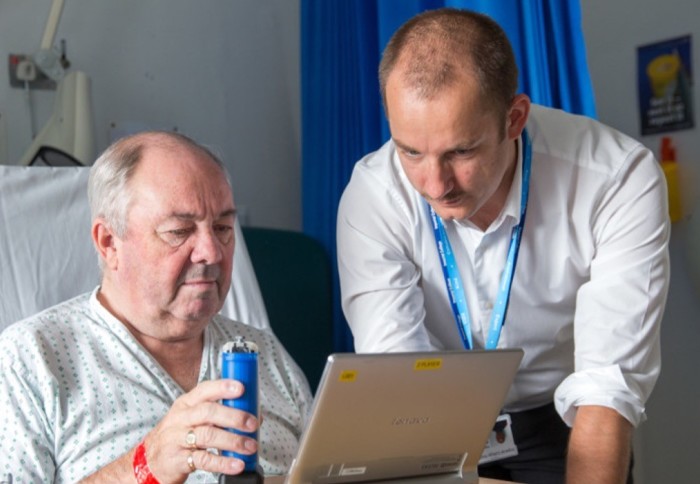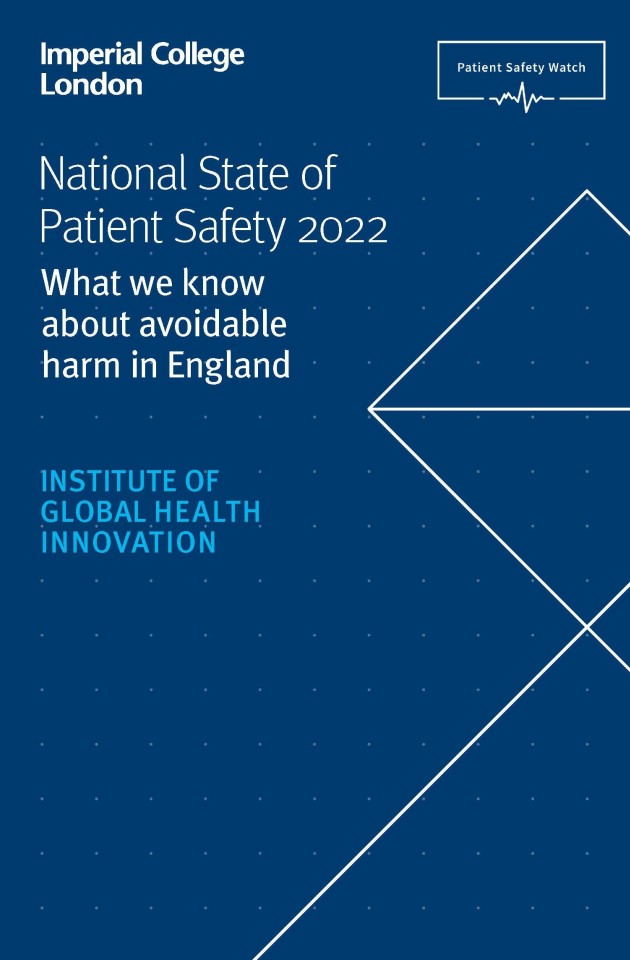New report describes a mixed picture for patient safety in England

Report on national state of patient safety shows some areas of progress – but a need for renewed focus and better data
Keeping patients safe during their care and treatment should be at the heart of every health system. The report, “National State of Patient Safety 2022: What we know about avoidable harm in England ”, produced by the Patient Safety and Translational Research Centre (NIHR) and Centre for Health Policy at the Institute of Global Health Innovation (IGHI) and funded by the charity Patient Safety Watch, explores progress and identifies areas for improvement in patient safety nationally, based on analysis of publicly available data over the past 15 years.
Key findings:
- Progress in patient safety: There have been some outstanding achievements over the past 15 years, including dramatic reductions in specific causes of harm, and progress in creating a more positive safety culture in the NHS.
- Workforce pressures: There are some warning signs in the data, particularly around the pressures faced by the healthcare workforce, which have been exacerbated by the COVID-19 pandemic.
- Access to care: Increasing waiting lists for planned care, falls in the diagnosis of some long-term conditions, and significant pressures on emergency services mean that timely and equitable access to care has become an urgent patient safety issue.
- Variations in care: Analysis of mortality data shows regional variation, while national progress in the safety of maternity services masks local failures in care and poorer outcomes for women from Black, Asian and Mixed Ethnicity backgrounds.
- Data limitations: A broader array of data, that better reflect the reality of people’s journey through the health system, is needed to establish a more complete picture of patient safety in England.
Professor the Lord Ara Darzi, co-director of IGHI said: “The continuous improvement of patient safety is a priority for all modern healthcare systems. This report identifies issues linked to an under-resourced and over-stretched workforce, which is affecting staff wellbeing and public confidence, and most likely patient outcomes.”
Progress in patient safety
There have been major efforts to prioritise patient safety in England over the past two decades, which have translated into some outstanding achievements. For example, due to the concerted efforts of healthcare workers and the impetus provided by national campaigns, rates of some healthcare-associated infections (HAIs), such as C. difficile and MRSA, have reduced dramatically, and outcomes for people with Venous Thromboembolism (blood clots) and hip fractures have improved.
Progress in creating a more positive safety culture amongst the workforce is also evident in the data. There has been a welcome increase in the proportion of staff feeling that their organisation takes action to prevent the same incident from happening again, and in staff feeling that they are treated fairly when incidents occur – that said, one in four healthcare workers do not feel secure raising concerns about unsafe clinical practice, and two in five still do not feel they would be treated fairly in such circumstances.
Workforce pressures
This report identifies issues linked to an under-resourced and over-stretched workforce, which is affecting staff wellbeing and public confidence, and most likely patient outcomes. Professor the Lord Ara Darzi Co-Director, Institute of Global Health Innovation, Imperial College London
The NHS workforce entered the pandemic already experiencing high rates of work-related stress and burnout, a trend which has accelerated since the onset of the pandemic. In 2021, almost half of respondents to the NHS Staff Survey reported feeling unwell due to work-related stress during the previous 12 months. The NHS Staff Survey also shows increases in the proportion of workers concerned there are not enough staff to do their job properly. The NHS entered the pandemic with around 84,000 vacancies; as of June 2022, this figure stood at 132,000, representing about a tenth of the workforce.
Some of the gains made in patient safety are at risk due to the impact of COVID-19. In the past few years, healthcare services have become less safe due in large part to the pandemic’s impact on timely, and sometimes equitable, access to healthcare services – whether that is access to a GP, a specialist, a paramedic, or an emergency care doctor.
Access to care
Dramatic changes in the way that healthcare services were delivered were necessary during the height of the pandemic to contain the spread of COVID-19. However, the indirect effect of this has been record numbers of people waiting to receive planned care, and falls in the diagnosis of long-term conditions such as chronic obstructive pulmonary disease (COPD) and heart failures.
Significant pressures on emergency services are evident, with worsening ambulance response times for potentially serious conditions, an increasing proportion of ambulance handovers experiencing a delay, and increasing numbers of people waiting in A&E.
All of which mean that the timely and equitable access to care has become an urgent patient safety issue.
Variations in care
Analysis of mortality data shows variations between hospitals and regions in England, offering valuable opportunities for shared learning across the NHS. Research also shows wide variation in the proportion of hospital deaths reported by trusts as due to problems in care, as part of the new Learning from Deaths guidance.
Improvements in the safety of maternity care is evident in the national-level data, with reductions in rates of stillbirths, neonatal deaths, babies diagnosed with brain injury and maternal deaths in recent years. However, this rate of improvement lags behind the Government’s own targets, and several recent inquiries into dreadful failures of care provide a sombre reminder of the progress still to be made.
James Titcombe, Trustee at Patient Safety Watch, said: “Unless the pace of improvement in maternity safety increases, the government’s own targets relating to maternity safety for 2025 will be missed.”
Improving the outcomes and experiences for women from Black, Asian and Mixed ethnicity groups, is a pressing priority. Women from Black ethnic backgrounds are four times more likely to die, and women from Asian or Mixed ethnicity backgrounds were almost twice as likely to die, during their pregnancy, compared to White women.
Data limitations
The patient safety data that forms the basis for the report are from publicly available sources – global datasets, national databases, data collected from local systems, reporting and learning mechanisms and staff and patient surveys. These measure specific forms of harm and relate to outcomes after an event has occurred.
 Melanie Leis, Director of Operations (interim), Centre for Health Policy, IGHI, explains: “There are limitations to this approach, best illustrated by the analogy of trying to drive a car by only looking through the rear-view mirror. In other words, these data can only tell you how safe care has been in the past, but not how safe it is in real-time or will be in the future.”
Melanie Leis, Director of Operations (interim), Centre for Health Policy, IGHI, explains: “There are limitations to this approach, best illustrated by the analogy of trying to drive a car by only looking through the rear-view mirror. In other words, these data can only tell you how safe care has been in the past, but not how safe it is in real-time or will be in the future.”
To address this and improve the data used to inform improvements in patient safety, the report recommends improvements in the breadth of patient safety data collected, to better reflect the reality of people’s journey through the health system, and in the accuracy of key patient safety measures, like rates of avoidable harm and death.
Looking forward
Further research, together with routine data collection, as well as looking at markers for future poor outcomes will be vital to making gains in patient safety. This should include data that measures and responds to risks and harm across the continuum of care, not just in hospital; is collected in real time, not just from past events; reflects how safe people feel, not just how safe they are clinically; and monitors whether some people are less safe than others, particularly those from disadvantaged or minority ethnic groups. Patient safety can only be accurately monitored when it is seen and truly understood from the patient’s perspective.
Professor the Lord Ara Darzi said: “The Institute of Global Health Innovation looks forward to working with patients and our partners and generating evidence to improve the safety of patients in England and around the world.”
Article text (excluding photos or graphics) © Imperial College London.
Photos and graphics subject to third party copyright used with permission or © Imperial College London.
Reporter
Victoria Murphy
Institute of Global Health Innovation